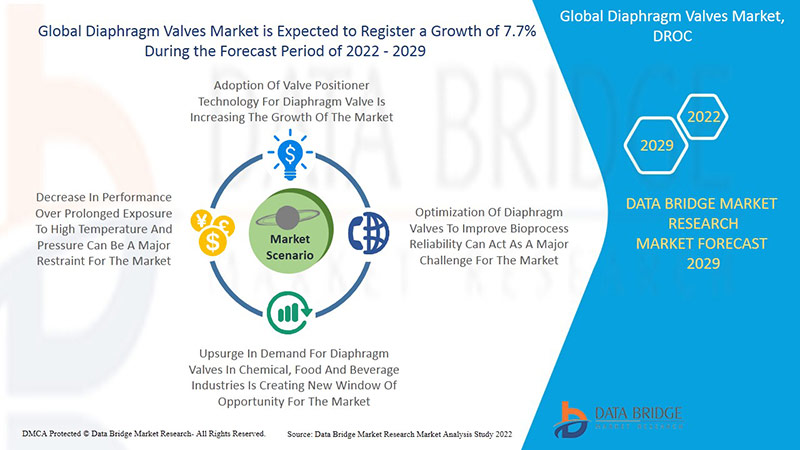Global Diaphragm Valves Market is forecasted to grow at 7.7% with factor such as heaving demand for electricity and energy generation globally and adoption of valve positioner technology for diaphragm valve, this can act as a major factor for the growth of the market.
The companies are investing heavily on developing valve positioner technology for diaphragm valve as it is the next big step in the semiconductor industry.
Diaphragm Valves Market Scenario
According to Data Bridge Market Research, the market for global diaphragm valves in Asia Pacific has the highest market share followed by North America and Europe. Market leader Crane Co. accounts an estimated market share of approximately 8.59% in the global market. The company has gained outstanding sale by providing Diaphragm valves products, services and entering partnerships which strengthens its product portfolio.
For instance,
- In December 2021, Crane Co. opened a Saunders factory in Cwmbran, UK. The main objective of this factory launch was to enhance its production capabilities in the region, as there is a growing demand from the consumer for advanced valve products. Through this company expanded its market.
- In October 2021, Crane Co. opened a Valves factory in Satara, India. The main objective of this factory launch was to enhance its production capabilities in the region for various types of valves and Engineered Check products. This strategic opening of the facility helped the company to strengthen its regional presence.
Now the question is which other regions Crane Co., GEA Group Aktiengesellschaft, and ALFA LAVAL, are targeting? Data Bridge Market Research has forecasted a large growth in Asia-Pacific diaphragm valves market and the market leaders are targeting China, Japan and India to be their next pocket revenue for 2022.
The diaphragm valves is becoming more competitive every year with companies Crane Co., GEA Group Aktiengesellschaft, ALFA LAVAL, Watson-Marlow Fluid Technology Group as they are the market leaders for Diaphragm valves. The Data Bridge Market Research new reports highlight the major growth factors and opportunities in diaphragm valves market.
For more analysis on the diaphragm valves request for a briefing with our analysts https://www.databridgemarketresearch.com/speak-to-analyst/?dbmr=global-diaphragm-valves-market
Diaphragm Valves Market Developments
- In May 2021, ALFA LAVAL has approved Central States Industrial Equipment and Service, Inc. (CSI) for Service Provider. They key feature of this partnership was to enhance the services offered in sanitary pumps and valves for consumer. Through this both the companies benefited and expanded there market.
- In April 2021, ALFA LAVAL launched the updated version of DV-ST Ultra-Pure valve. The key feature of this product update was the enhanced aseptic processing efficiency and cost effective. Through this company strengthen it product portfolio and offered quality products in affordable prices for the consumer.
Scope of the Diaphragm Valves Market
All country based analysis of global diaphragm valves market is further analysed based on maximum granularity into further segmentation. On the basis of type, the diaphragm valves market is segmented into straight and weir. On the basis of valve type, the global diaphragm valves market has been segmented into two-way valve, block-T-valve, forged-T-valve, tandem valve, block tank outlet valve, multi-port valve, forged tank outlet valve and others. On the basis of controller, the global diaphragm valves market has been segmented into manual, pneumatic, electric, hydraulic and others. On the basis of end connection, the global diaphragm valves market has been segmented into flanged, butt weld, tri clamp and others. On the basis of material, the global diaphragm valves market has been segmented into metal, fluorine plastic, rubber, polytetrafluorethylene (PTFE) and others. On the basis of size, the global diaphragm valves market has been segmented into below 8”, 8”, 12”, 14”, 16”, 18”, 20” and others. On the basis of body material, the global diaphragm valves market has been segmented into solid plastic, hygiene valve, fluorine plastic and others. On the basis of switch type, the global diaphragm valves market has been segmented into limit switch, basic switch, indicator switch and others. On the basis of usage, the global diaphragm valves market has been segmented into single use and multi-use. On the basis of distribution channel, the global diaphragm valves market has been segmented into online channel and offline channel. On the basis of end user, the global diaphragm valves market has been segmented into food and beverages, pharmaceuticals, biopharma, chemical, water and wastewater treatment, power, mining and minerals, pulp and paper and others.
To know more about the study https://www.databridgemarketresearch.com/reports/global-diaphragm-valves-market
Key Pointers Covered in Diaphragm Valves Market Industry Trends and Forecast to 2029
- Market Size
- Market Standards and Changes
- Market Trials in Different Regions
- Market Requirements in Different Regions
- Market Shares in Different Regions
- Recent Developments for Market Competitors
- Recent Market Value for Different regions
- Sales Data for Market Competitors
- Market Key Vendors and Disruptors Study
Key Market Competitors Covered in the Report
- Crane Co.
- GEA Group Aktiengesellschaft
- ALFA LAVAL
- Watson-Marlow Fluid Technology Group
- GEMU Group
- ITT INC.
- Christian Burkert GmbH Co. KG
- Aquasyn LLC
- ASTECH VALVE CO.,LTD.
- Century Instrument Company
- FIP - Formatura Iniezione Polimeri S.p.A.
- FLOWONE
- G.J. Johnson & Sons Ltd.
- GCE Group AB
- Gopfert AG
- International Polymer Solutions
- IPEX Inc.
- KDVFlow
- KOSEN VALVE
- NIPPON DAIYA VALVE
- NTGD Diaphragm Valve
- Plast-O-Matic Valves, Inc.
- PureValve
- SEMON ENGG INDUSTRIES PVT LTD
- Swagelok Company
- Valves Only
- Valvorobica Industriale S.p.A.
- Xiamen Kemus Valve Co., Ltd
Above are the key players covered in the report, to know about more and exhaustive list of diaphragm valves market, contact us https://www.databridgemarketresearch.com/toc/?dbmr=global-diaphragm-valves-market
Research Methodology: Global Diaphragm Valves Market
Data collection and base year analysis is done using data collection modules with large sample sizes. The market data is analysed and forecasted using market statistical and coherent models. Also market share analysis and key trend analysis are the major success factors in the market report. To know more please request an analyst call or can drop down your enquiry.
The key research methodology used by DBMR research team is data triangulation which involves data mining, analysis of the impact of data variables on the market, and primary (industry expert) validation. Apart from this, data models include vendor positioning grid, market time line analysis, market overview and guide, company positioning grid, company market share analysis, standards of measurement, top to bottom analysis and vendor share analysis. To know more about the research methodology, drop in an inquiry to speak to our industry experts.
Primary Respondents
- Demand Side: Managers, Directors, Diaphragm Valves Engineer, Semiconductor Experts, Flow System Designer, Water Treatment Plant Engineer, Power Plant Engineer.
- Supply Side: Service Providers, OEMs Companies, Marketing Managers, Logistics Managers and C-Level Executives among others.
Related Reports
- Global Industrial Valves and Actuators Market - Industry Trends and Forecast to 2028
- Global Ball Valves Market - Industry Trends and Forecast to 2028
- Global Control Valves Market - Industry Trends and Forecast to 2028
- Global Aerosol Valves Market - Industry Trends and Forecast to 2027
Browse in Semiconductors and Electronics Category Related Reports@ https://www.databridgemarketresearch.com/report-category/semiconductors-and-electronics/











